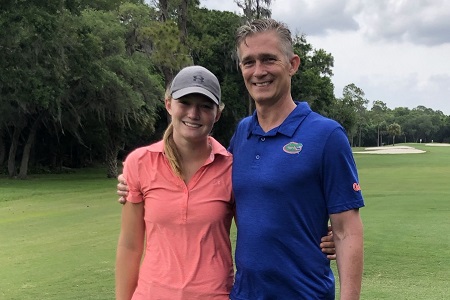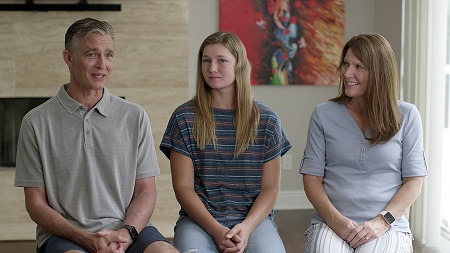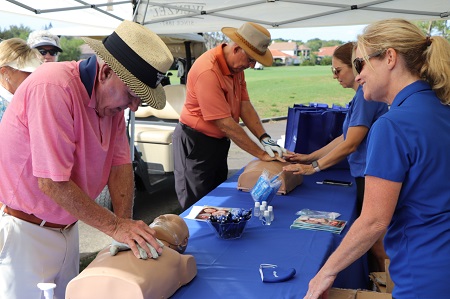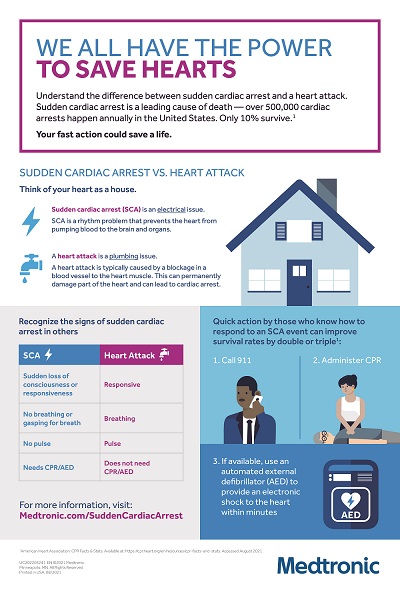Beating the Odds: When Steve Ryan’s Heart Suddenly Stopped
Steve’s teenage daughter swung into action. Could you do the same?
Steve Ryan couldn’t feel it coming.
“I felt fine,” he said. “A little tired from a busy day maybe, but that was it.”
One minute he was helping his 15-year-old daughter Kaitlin practice her short game on the golf course near their Florida home. The next, he was face down on the putting green, unconscious. His heart just stopped.
“I don’t remember a thing,” Steve said.
Kaitlin raced up from 100 yards away, turned her dad over and found no pulse. She quickly called her mother Sharon, a nurse, and just as quickly dialed 9-1-1. Then she started CPR.
“We learned CPR in middle school and practiced on stuffed animals,” Kaitlin said. “I’m not certified in CPR but I used what I remembered from school. I didn’t have a choice. I had to act.”
Sharon used a smartphone app to pinpoint Steve and Kaitlin’s location and got there before the ambulance. She took turns with Kaitlin, performing chest compressions until help arrived. Paramedics defibrillated Steve four times. His heart finally started beating again, 12 minutes after he collapsed.

“It was a relief when they gave me the thumbs up, but the nurse part of me knew this was just the start,” Sharon said. “Would he wake up, and if he did, would he still be Steve?”
It took three days to find out.
What is Sudden Cardiac Arrest?
Steve suffered Sudden Cardiac Arrest (SCA), sometimes referred to as Sudden Cardiac Death (SCD). Unlike a heart attack, which involves a blockage in the blood stream that restricts blood flow and damages the heart, SCA is an electrical disturbance that causes the heart itself to suddenly stop beating.1 Nine out of 10 people who experience SCA outside of a hospital setting don’t survive,2,3 usually because help just can’t get to them in time. In the United States alone, SCA kills 1,000 people every day outside of a hospital setting.4 Globally, more people die from cardiac arrest than colon cancer, breast cancer, prostate cancer, influenza, pneumonia, auto accidents, HIV, firearms and house fires combined.5
Steve would not be one of them.
Doctors induced a coma and lowered Steve’s body temperature to 91 degrees for 24 hours.

For three agonizing days, his family waited to learn his fate, until doctors brought him out of the coma. A nurse told Steve he was in the hospital and asked if he knew why.
“I told her I had no idea,” Steve said. “Then she explained what happened, that Kaitlin had started CPR and saved my life. The gravity of that just floored me. And then to imagine the anguish of what those days must have been like for my family.”
“I think his first words to me were ‘Hi honey,’” Sharon said. “So I knew right away that Steve was still Steve. It was pure joy. And we got the news on Kaitlin’s 16-th birthday.”
“Best birthday present ever, that’s for sure,” Kaitlin added.
Preventing Sudden Cardiac Arrest
Although there are a variety of risk factors associated with SCA, the precise trigger is often a mystery. And for the 1 in 10 victims who survive SCA, there’s the constant worry that it could happen again. Because next time, help may not be so close at hand.
“That’s why the ICD was a no-brainer for me,” Steve said.
Doctors told the Ryan’s that Steve was a good candidate to receive an implantable cardioverter defibrillator, or ICD. The device is implanted under the skin, near the collarbone. Wires, or leads, connect the device to the heart. Facts about ICDs.
“ICDs are small, battery-powered devices that constantly monitor the rhythm and activity of the heart,” said Dr. Rob Kowal, Chief Medical Officer for the Cardiac Rhythm Management division at Medtronic. “If the device senses a problem, it can send either high-energy shocks or low-energy, electrical impulses to help return the heart to normal rhythm.”
“Most of the time I don’t even know it’s there,” Steve said of his Medtronic ICD. “It’s great knowing that if something happens again, my device is there to help me.”
“In the beginning we felt like we had to be with him every minute in case something happened,” Sharon said. “But now we know that if he’s out walking the dog by himself, or whatever, that the ICD is watching out for him. It really does provide peace of mind.”
Learn more about heart rhythm disorders and treatments.
Living on ‘Bonus Time’
Steve exercises regularly and is now back to living an active lifestyle. Kaitlin recently organized Chip In for Sudden Cardiac Arrest, a golf event that raised more than $30,000 for the American Heart Association and the Sudden Cardiac Arrest Foundation. All 80 of the golfers who attended also received hands-on CPR training.

“It could happen to anyone,” Kaitlin said. “It’s so important that people are able to recognize what’s happening, get help quickly and perform CPR. After our experience, it seemed really important to give back in some way and help raise awareness,” she said.
“I feel like I’m living on bonus time,” Steve said. “The outcome could have been very different. We’re grateful and thankful and looking forward to each new day.”
What You Can Do
October is Sudden Cardiac Awareness Month. There are many things you can do to learn more about SCA, how to spot it and how to respond if you see it happening.
- Learn the risk factors. SCA can happen to anyone, but there are a variety of factors that increase a person’s risk.
- Learn to spot SCA. If you suspect someone is experiencing SCA, the American Heart Association says there are signs to look for.
- Learn how to respond. Quick action is critical to saving someone who has suffered SCA. Even basic training in hands-only CPR can save a life.

1 Mayo Clinic. Sudden Cardiac Arrest. Accessed November 2019.
2 Institute of Medicine. Strategies to Improve Cardiac Arrest Survival: A Time to Act. Washington, DC: The National Academies Press; 2015. https://www.nap.edu/read/21723/chapter/1#xiexternal icon. Accessed January 16, 2018.
3 Neumar RW, Eigel B, Callaway CW, et al. American Heart Association response to the 2015 Institute of Medicine report on strategies to improve cardiac arrest survival. Circulation 2015;132(11):1049–1070.
4 Benjamin EJ, Virani SS, Callaway CW, et al. Heart disease and stroke statistics—2018 update: a report from the American Heart Association. Circulation 2018;137(12):e67–e492.
5 American Heart Association. CPR Facts & Stats. Accessed November 2019.
L001-09232021
Clinical and Economic Evidence Driving Patient-Centered Care
Read How: Meaningful Innovation
